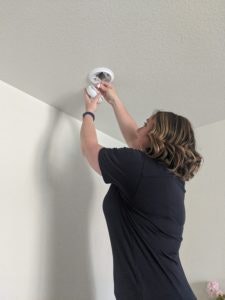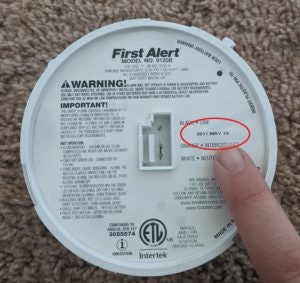Smoke Alarm and Carbon Monoxide Alarm Safety

Did you know that three out of five home fire deaths were caused by fires in properties with no smoke alarms or smoke alarms that failed to operate?
Having proper working smoke alarms in your home saves lives. Follow these smoke alarm safety tips :
- Install smoke alarms inside each bedroom, outside each sleeping area, and on every level of the home, including the basement.
- Smoke alarms should be installed at least 10 feet from a cooking appliance to minimize false alarms when cooking.
- Mount smoke alarms high on walls or ceilings (remember, smoke rises). Wall-mounted alarms should be installed not more than 12 inches away from the ceiling( to the top of the alarm).
- For the best protection, install interconnecting smoke alarms. When one smoke alarm sounds, they all sound. Interconnection can be done using hard-wired or wireless technology.
- TEST YOUR SMOKE ALARMS ONCE A MONTH. You want to make sure the battery is properly working. If not, replace the battery!
- Check the manufacture date! Smoke alarms expire and are usually only good for 10 years. Check your manufacturer recommendations for more information.

Carbon Monoxide (CO) alarms are just as important to have in your home. CO alarms were the most commonly reported calls for the fire service in 2017(nfpa.org). In 2016, 399 people died of unintentional non-fire carbon monoxide poisoning per the Centers for Disease Control and Prevention (CDC). Follow these CO alarm safety tips:
- CO alarms should be installed in a central location outside each sleeping area and on every level of the home.
- For best protection, interconnect all CO alarms throughout the home. When one sounds they all sound.
- Test CO alarms at least once a month. You want to make sure the battery is properly working. If not, replace the battery!
- CO alarms expire! Replace them according to the manufacturer’s instructions.
Ways to prevent unwanted CO:
- Warming a vehicle – remove it from the garage immediately after starting it. Make sure the exhaust pipe of any running vehicle is not covered in any way.
- During and after a snowstorm, make sure all vents for the dryer, furnace, stove, and fireplace are clear of snow build-up.
- Use a generator in a well-ventilated location outdoors away from windows, doors, and vent openings.
- Gas or charcoal grills can produce CO. Use them outside only!
Symptoms of CO poisoning:
CO enters the body through breathing. CO poisoning can be confused with flu symptoms, food poisoning, and other illnesses. Some symptoms include shortness of breath, nausea, dizziness, lightheadedness, or headaches. High levels of CO can be fatal, causing death within minutes.
The concentration of CO, measured in parts per million (ppm)is a determining factor in the symptoms of an average, healthy adult.
- 50 ppm: No adverse effects with 8 hours of exposure.
- 200 ppm: Mild headache after 2-3 hours of exposure.
- 400 ppm: Headache and nausea after 1-2 hours of exposure.
- 800 ppm: Headache, nausea, and dizziness after 45 minutes; collapse and unconsciousness after 1 hour of exposure.
- 1,000 ppm: Loss of consciousness after 1 hour of exposure.
- 1,600 ppm: Headache, nausea, and dizziness after 20 minutes of exposure.
- 3,200 ppm: Headache, nausea, and dizziness after 5-10 minutes; collapse and unconsciousness after 30 minutes of exposure.
- 6,400 ppm: Headache and dizziness after 1-2 minutes; unconsciousness and danger of death after 10-15 minutes of exposure.
- 12,800 ppm: Immediate physiological effects, unconsciousness, and danger of death after 1-3 minutes of exposure.
If you need assistance in getting or installing your smoke or CO alarms, please call us at 303-288-0835.
Source NFPA.org
